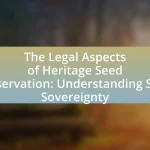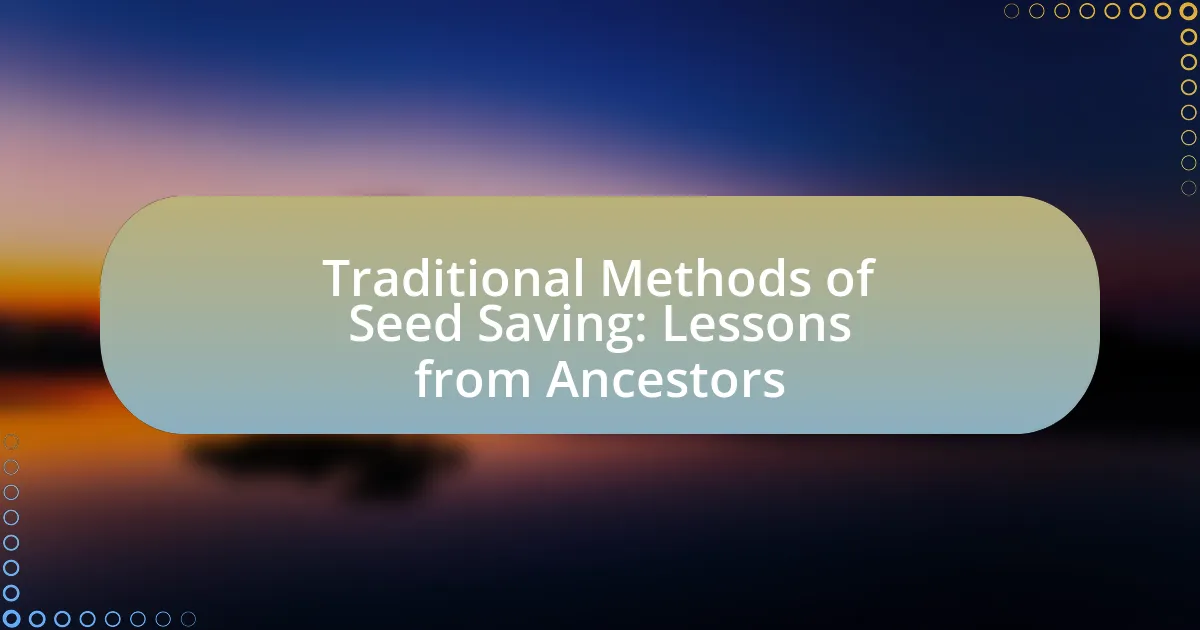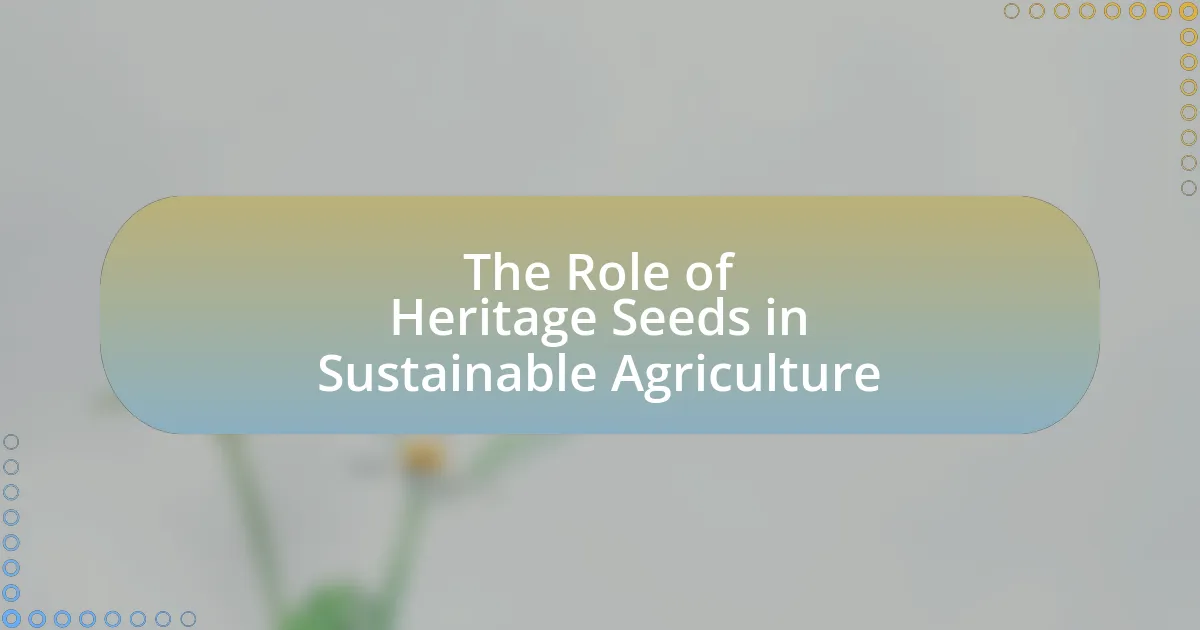The article examines the impact of climate change on heritage seed preservation, highlighting how altered growing conditions, increased temperatures, and extreme weather events threaten biodiversity and the viability of traditional seed varieties. It discusses specific climate factors that jeopardize heritage seeds, including changes in precipitation patterns and the rise of pests and diseases. The importance of preserving genetic diversity for food security and resilience against climate change is emphasized, along with strategies for mitigating these impacts, such as establishing seed banks and promoting sustainable agricultural practices. Additionally, the article addresses the challenges faced by heritage seed banks and the role of community initiatives in safeguarding these vital genetic resources.

What is the Impact of Climate Change on Heritage Seed Preservation?
Climate change negatively impacts heritage seed preservation by altering growing conditions and threatening biodiversity. Increased temperatures, altered precipitation patterns, and extreme weather events can lead to reduced crop yields and the loss of traditional seed varieties. For instance, a study published in the journal “Global Change Biology” indicates that climate change could lead to a decline in the genetic diversity of crops, which is crucial for resilience against pests and diseases. Additionally, heritage seeds, often adapted to specific local climates, may struggle to survive in changing environments, further endangering their preservation.
How does climate change affect the viability of heritage seeds?
Climate change negatively affects the viability of heritage seeds by altering environmental conditions essential for their growth and reproduction. Increased temperatures, altered precipitation patterns, and the prevalence of extreme weather events can lead to reduced germination rates and lower seed quality. For instance, research indicates that temperature increases can accelerate seed aging and diminish their ability to germinate, as evidenced by studies showing that seeds exposed to higher temperatures exhibit reduced viability over time. Additionally, changes in rainfall patterns can affect soil moisture levels, further impacting seed development and survival.
What specific climate factors threaten heritage seed preservation?
Specific climate factors that threaten heritage seed preservation include increased temperatures, altered precipitation patterns, and extreme weather events. Increased temperatures can lead to heat stress on plants, reducing seed viability and altering growth cycles. Altered precipitation patterns can cause droughts or flooding, both of which negatively impact seed production and soil health. Extreme weather events, such as hurricanes or storms, can physically damage crops and disrupt agricultural practices. These factors collectively jeopardize the genetic diversity and resilience of heritage seeds, which are crucial for sustainable agriculture and food security.
How do changing temperatures influence seed germination rates?
Changing temperatures significantly influence seed germination rates by affecting the metabolic processes within seeds. Higher temperatures generally accelerate germination, as they enhance enzyme activity and increase the rate of water uptake, leading to faster seedling emergence. However, excessively high temperatures can be detrimental, causing heat stress that may inhibit germination or lead to seed mortality. Research indicates that optimal temperature ranges for germination vary among species; for example, many crops germinate best between 20°C and 30°C. Deviations from these optimal ranges can result in reduced germination rates, as demonstrated in studies showing that temperatures above 35°C can decrease germination success in sensitive species.
Why is heritage seed preservation important in the context of climate change?
Heritage seed preservation is crucial in the context of climate change because it maintains genetic diversity essential for adapting crops to changing environmental conditions. This genetic diversity allows for the development of resilient plant varieties that can withstand extreme weather, pests, and diseases exacerbated by climate change. For instance, a study by the Food and Agriculture Organization highlights that diverse seed banks can provide vital traits such as drought resistance and pest tolerance, which are increasingly necessary as climate patterns shift. Thus, preserving heritage seeds not only safeguards agricultural biodiversity but also enhances food security in the face of climate challenges.
What role do heritage seeds play in biodiversity and food security?
Heritage seeds play a crucial role in biodiversity and food security by preserving genetic diversity and enabling resilience against climate change. These seeds, often heirloom varieties, contribute to a diverse gene pool that supports ecosystem stability and adaptability. For instance, a study by the Food and Agriculture Organization (FAO) highlights that heritage seeds can withstand pests and diseases better than modern hybrids, thus ensuring a more reliable food supply. Additionally, the preservation of these seeds helps maintain traditional agricultural practices and local food systems, which are vital for food sovereignty and cultural identity.
How can heritage seeds contribute to climate resilience in agriculture?
Heritage seeds contribute to climate resilience in agriculture by offering genetic diversity that enhances adaptability to changing environmental conditions. This genetic variability allows crops to withstand stresses such as drought, pests, and diseases, which are increasingly prevalent due to climate change. For instance, studies have shown that heritage varieties often possess traits that enable them to thrive in less-than-ideal conditions, thereby ensuring food security. Additionally, the use of heritage seeds can promote sustainable farming practices, as these seeds are typically well-suited to local ecosystems and require fewer chemical inputs, further supporting resilience against climate impacts.

What are the challenges faced in preserving heritage seeds due to climate change?
Climate change poses significant challenges to preserving heritage seeds, primarily through altered growing conditions, increased pest and disease pressures, and loss of biodiversity. These factors disrupt traditional agricultural practices, making it difficult for farmers to maintain the genetic diversity essential for heritage seeds. For instance, rising temperatures and unpredictable rainfall patterns can lead to reduced crop yields and affect seed viability. Additionally, climate change can exacerbate the spread of pests and diseases, threatening the health of heritage seed varieties that may lack resistance. According to a study published in the journal “Global Change Biology,” climate change could lead to a 10-20% decline in crop yields by 2050, further endangering the preservation of these vital genetic resources.
What are the main threats to heritage seed banks?
The main threats to heritage seed banks include climate change, loss of biodiversity, and inadequate funding. Climate change affects seed viability and growth conditions, leading to reduced genetic diversity. Loss of biodiversity occurs as traditional farming practices decline, diminishing the number of heritage seeds preserved. Inadequate funding limits the capacity of seed banks to maintain and expand their collections, making them vulnerable to extinction. According to a report by the Food and Agriculture Organization, climate change could threaten up to 50% of crop varieties by 2100, highlighting the urgency of addressing these threats.
How does extreme weather impact seed storage facilities?
Extreme weather significantly impacts seed storage facilities by compromising their structural integrity and environmental controls. For instance, severe storms can cause physical damage to buildings, while extreme temperatures and humidity levels can lead to seed degradation. Research indicates that fluctuations in temperature and moisture can reduce seed viability by up to 50% within a few years if not properly managed. Additionally, flooding can contaminate stored seeds with pathogens, further threatening their preservation. These factors underscore the vulnerability of seed storage facilities to climate-related events, necessitating improved infrastructure and management practices to safeguard heritage seeds.
What economic factors complicate heritage seed preservation efforts?
Economic factors complicating heritage seed preservation efforts include the high costs associated with maintaining seed banks, limited funding for conservation programs, and the market dominance of commercial seed varieties. The maintenance of seed banks requires significant financial resources for storage, research, and management, which can strain budgets, especially in regions with limited agricultural funding. Additionally, many conservation programs rely on grants and donations, which can be inconsistent and insufficient to cover ongoing operational costs. The prevalence of commercial seed varieties, often backed by large agribusinesses, creates a competitive market that undervalues heritage seeds, making it economically challenging for farmers to prioritize their preservation over more profitable crops. This economic landscape ultimately hinders the sustainability and viability of heritage seed preservation initiatives.
How do changing agricultural practices affect heritage seed preservation?
Changing agricultural practices negatively affect heritage seed preservation by promoting monoculture and the use of hybrid seeds, which reduces genetic diversity. Monoculture farming focuses on growing a single crop variety, leading to the neglect of traditional heritage seeds that are often more resilient to pests and climate variations. Additionally, the reliance on hybrid seeds, which are bred for uniformity and high yield, diminishes the cultivation of diverse seed varieties that have been passed down through generations. Research indicates that the loss of biodiversity in agriculture can lead to increased vulnerability of food systems to climate change, as diverse heritage seeds can provide essential traits for adaptation.
What shifts in farming techniques are being observed due to climate change?
Shifts in farming techniques due to climate change include the adoption of drought-resistant crops, changes in planting schedules, and increased use of precision agriculture technologies. Farmers are increasingly selecting crop varieties that can withstand extreme weather conditions, such as heat and drought, to maintain yields. For instance, a study by the Food and Agriculture Organization (FAO) highlights that regions experiencing reduced rainfall are shifting to crops that require less water, thereby ensuring food security. Additionally, farmers are adjusting planting dates to align with changing climate patterns, which can affect growth cycles. The integration of precision agriculture, utilizing data analytics and technology, allows for more efficient resource management, optimizing inputs like water and fertilizers in response to climate variability.
How do these shifts impact the cultivation of heritage seeds?
Shifts in climate change significantly impact the cultivation of heritage seeds by altering growing conditions, which can lead to reduced yields and increased vulnerability to pests and diseases. For instance, rising temperatures and changing precipitation patterns can disrupt traditional planting and harvesting schedules, making it difficult for farmers to maintain the genetic diversity and resilience of heritage seeds. Research indicates that heritage seeds, which are often adapted to specific local climates, may struggle to thrive under these new conditions, leading to a decline in their cultivation. A study published in the journal “Agricultural Systems” highlights that climate variability can reduce the viability of heritage seed varieties, emphasizing the need for adaptive strategies to preserve these important genetic resources.

What strategies can be implemented to mitigate the impact of climate change on heritage seed preservation?
To mitigate the impact of climate change on heritage seed preservation, strategies such as establishing seed banks, promoting agro-biodiversity, and implementing sustainable agricultural practices can be employed. Seed banks serve as repositories for genetic material, ensuring that diverse seed varieties are preserved for future use, which is crucial as climate conditions change. Promoting agro-biodiversity involves cultivating a variety of crops that can withstand different climate stresses, thereby enhancing resilience. Sustainable agricultural practices, such as crop rotation and organic farming, help maintain soil health and reduce dependency on chemical inputs, further supporting the preservation of heritage seeds. These strategies are supported by research indicating that genetic diversity in crops can enhance resilience to climate variability, as noted in studies by the Food and Agriculture Organization.
How can conservation efforts be enhanced to protect heritage seeds?
Conservation efforts can be enhanced to protect heritage seeds by implementing community seed banks and promoting agro-biodiversity. Community seed banks allow local farmers to store and share heritage seeds, ensuring their availability and genetic diversity. Research indicates that agro-biodiversity contributes to resilience against climate change, as diverse crops can better withstand environmental stresses. For instance, a study published in the journal “Agriculture, Ecosystems & Environment” highlights that diverse cropping systems can improve soil health and reduce vulnerability to pests and diseases. Additionally, educating farmers about sustainable practices and the importance of heritage seeds can further strengthen conservation efforts.
What role do community seed banks play in preservation efforts?
Community seed banks play a crucial role in preservation efforts by safeguarding genetic diversity and promoting the cultivation of heritage seeds. These banks collect, store, and distribute seeds from local plant varieties, ensuring that unique genetic traits are maintained despite the pressures of climate change. For instance, a study by the Food and Agriculture Organization highlights that community seed banks can enhance food security by providing access to resilient crop varieties that are better suited to changing environmental conditions. This localized approach not only preserves biodiversity but also empowers communities to adapt agricultural practices in response to climate challenges.
How can technology aid in the preservation of heritage seeds?
Technology can aid in the preservation of heritage seeds through methods such as seed banking, genetic sequencing, and digital databases. Seed banking allows for the long-term storage of seeds in controlled environments, ensuring their viability despite climate change impacts. Genetic sequencing helps identify and catalog the genetic diversity of heritage seeds, which is crucial for breeding programs aimed at resilience. Digital databases facilitate the sharing of information about seed varieties, enabling farmers and researchers to access and utilize heritage seeds more effectively. These technological approaches collectively enhance the preservation efforts by safeguarding genetic diversity and ensuring the availability of heritage seeds for future generations.
What best practices can farmers adopt to support heritage seed preservation?
Farmers can adopt several best practices to support heritage seed preservation, including maintaining seed diversity, practicing organic farming, and participating in seed saving networks. Maintaining seed diversity ensures a wide genetic pool, which enhances resilience against climate change impacts. Organic farming practices, such as crop rotation and natural pest management, help sustain soil health and biodiversity, which are crucial for heritage seeds. Additionally, participating in seed saving networks allows farmers to share knowledge and resources, fostering a community dedicated to preserving these seeds. These practices collectively contribute to the sustainability and resilience of heritage seeds in the face of climate change.
How can crop rotation and polyculture benefit heritage seed varieties?
Crop rotation and polyculture can significantly benefit heritage seed varieties by enhancing biodiversity and improving soil health. These agricultural practices reduce pest and disease pressure, which is crucial for the survival of heritage seeds that may lack modern genetic resistance. For instance, rotating crops disrupts the life cycles of pests and pathogens, while polyculture promotes beneficial interactions among different plant species, leading to a more resilient ecosystem. Research indicates that diverse cropping systems can increase yields and reduce the need for chemical inputs, thereby supporting sustainable farming practices that are essential for preserving heritage seed varieties in the face of climate change.
What are the benefits of organic farming for heritage seed preservation?
Organic farming significantly benefits heritage seed preservation by promoting biodiversity and enhancing soil health. This agricultural method avoids synthetic pesticides and fertilizers, which can harm diverse plant species, thereby allowing heritage seeds to thrive in a more natural ecosystem. Research indicates that organic practices can increase the resilience of crops to climate change, as they often involve crop rotation and polyculture, which help maintain genetic diversity. For instance, a study published in the journal “Agriculture, Ecosystems & Environment” found that organic farming systems support a wider variety of plant species, which is crucial for preserving the genetic traits of heritage seeds. This genetic diversity is essential for adapting to changing climate conditions, ensuring that these seeds can withstand pests, diseases, and environmental stresses.
What practical steps can individuals take to support heritage seed preservation?
Individuals can support heritage seed preservation by participating in seed saving, which involves collecting and storing seeds from heirloom plants for future planting. This practice helps maintain genetic diversity and ensures the availability of traditional varieties that may be threatened by climate change. Additionally, individuals can join or support local seed banks and community gardens that focus on preserving heritage seeds, thereby fostering a network of shared resources and knowledge. Engaging in educational initiatives about the importance of biodiversity and sustainable agriculture also contributes to the preservation efforts. According to the Seed Savers Exchange, preserving heirloom seeds is crucial for maintaining agricultural diversity, which is increasingly threatened by climate change and industrial agriculture practices.





